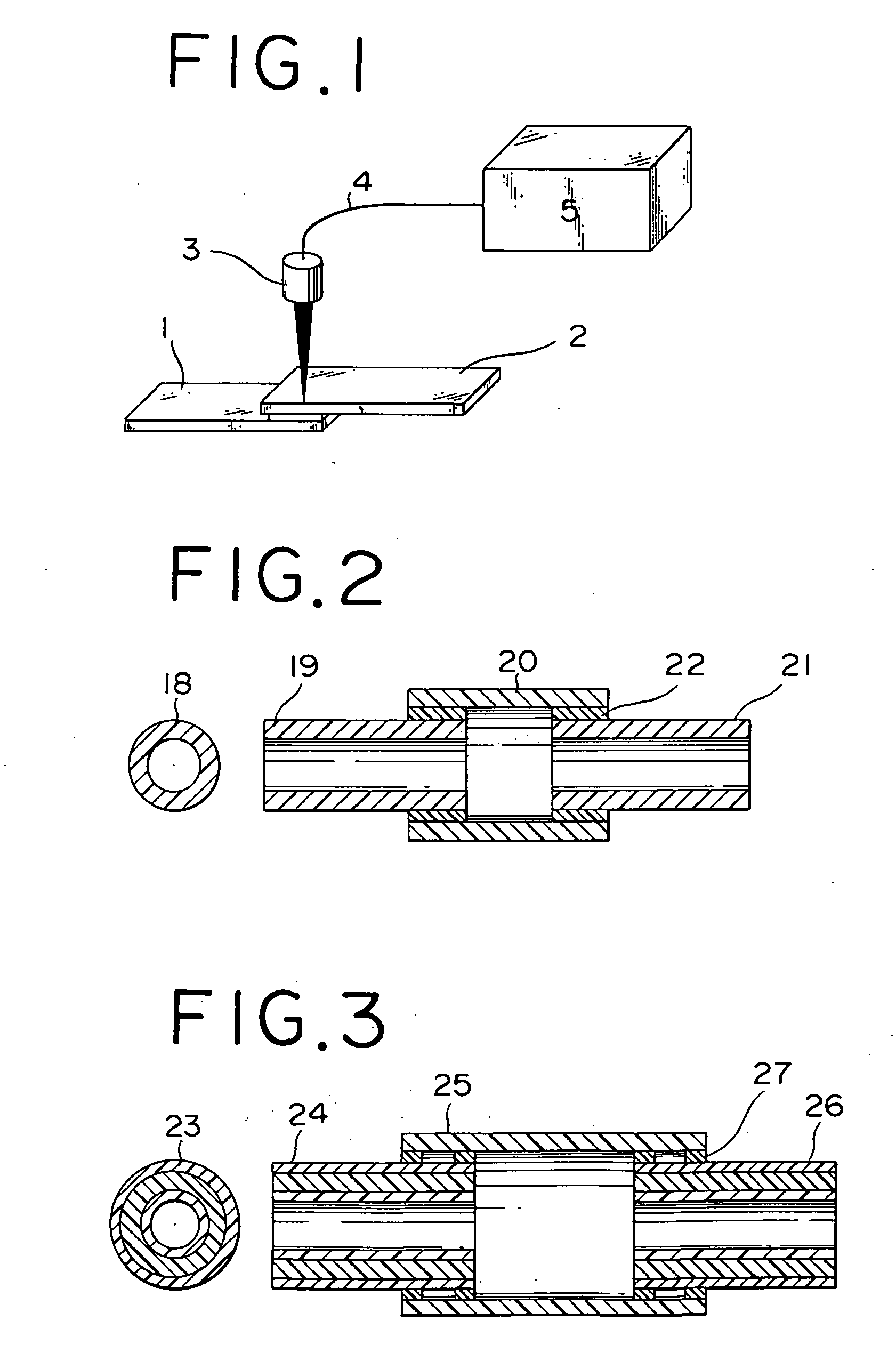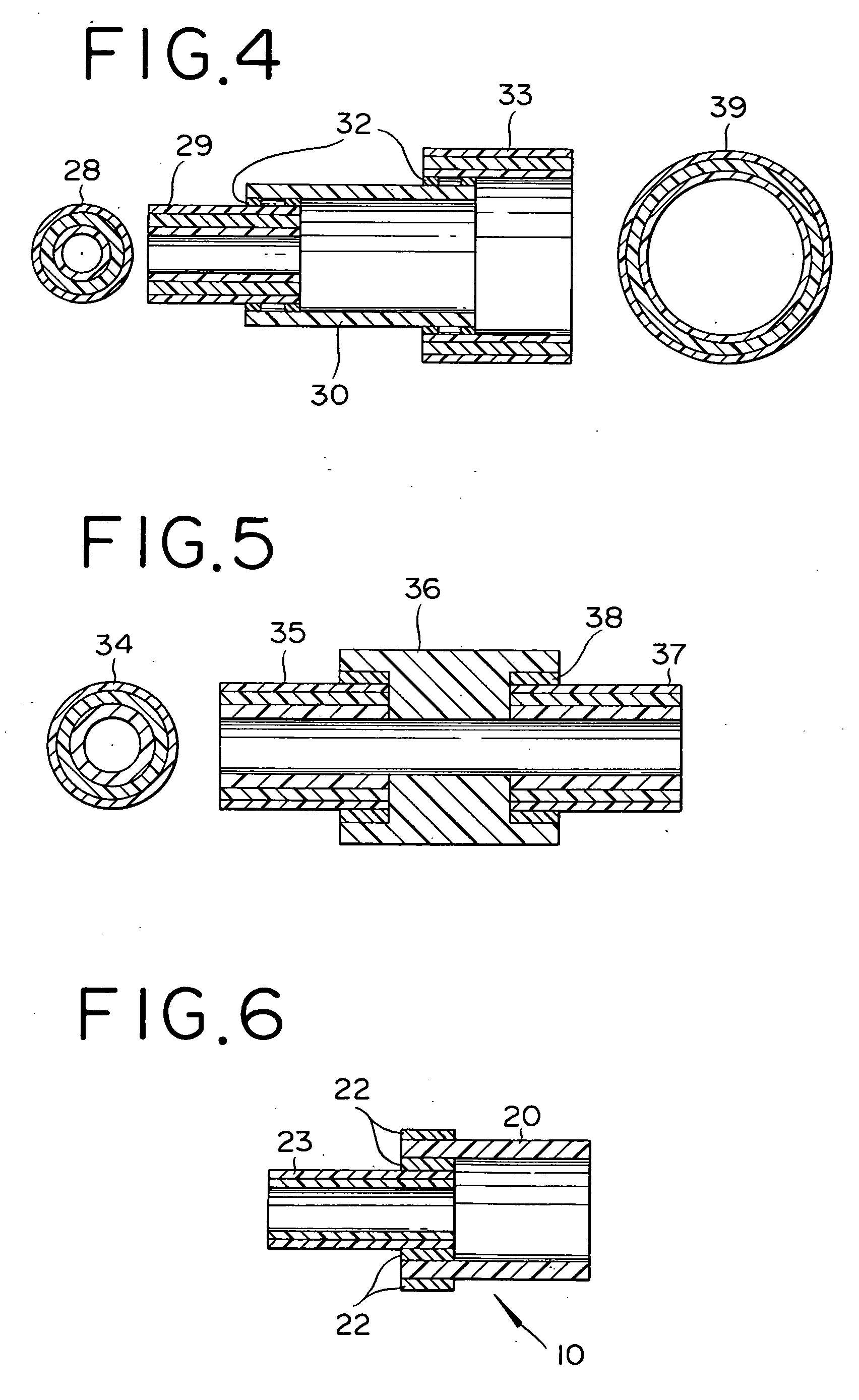Method for production of tubular article
a tubular and article technology, applied in the field of tubular article production, can solve the problems of difficult securing transparency and adhesiveness, inconvenient application, and inability to easily adhere to other resins, and achieve the effect of high adhesive strength and without affecting the appearance of the outsid
- Summary
- Abstract
- Description
- Claims
- Application Information
AI Technical Summary
Benefits of technology
Problems solved by technology
Method used
Image
Examples
production example 1
Production of Styrene Type Elastomer
[0091] In a pressure-resistant reaction vessel dried and displaced with nitrogen, 4.2 kg of cyclohexane as a solvent, 87 ml of 1.3 mol / l of sec-butyl lithium solution in cyclohexane as a polymerization initiator, and 1.0 kg of styrene were added and the styrene was polymerized at 40° C. Thereafter, 0.08 kg of tetrahydrofuran was added as a Lewis base and then 8.0 kg of isoprene and 1.0 kg of styrene were successively polymerized to obtain a polystyrene-polyisoprene-polystyrene type block copolymer. The obtained block copolymer was hydrogenated for 10 hours in cyclohexane in the presence of Pd / C as a catalyst in a hydrogen atmosphere of 1.96 MPa to obtain a triblock copolymer comprised of polystyrene-polyisoprene-polystyrene (hereinafter referred to as “styrene type elastomer”). The obtained hydrogenated triblock copolymer was found to have a number average molecular weight of 110,000, a vinyl bond content of 55%, and a hydrogenation ratio of 80%....
example 1
[0092] (1) By means of a tumbler, 85% by weight of the styrene type elastomer obtained in Production Example 1 and 15% by weight of polypropylene (random type polypropylene made by Sumitomo Mitsui Polyolefin Co., Ltd. and sold under the product code “F327”) were mixed. The resultant mixture was fed to a biaxial extruder (made by Krupp Werner & Pfleiderer and sold under the product code “ZSK-25”) and kneaded therein at 200° C., then extruded in the shape of a strand, and shredded to produce thermoplastic polymer composition pellets.
[0093] The thermoplastic polymer composition pellets were fed to a monoaxial extruder 3 (made by Takayasu Iron Works Ltd. and sold under the product code “PFE-50”) and extrusion molded through a circular type ring die at a preset temperature of 200° C. to obtain a monolayer tubular body (substrates A and C) having an outside diameter of 6 mm and an inside diameter of 4 mm.
[0094] (2) A monolayer tubular body (substrate B) having an outside diameter of 7.5...
example 2
[0096] (1) Two monolayer tubular bodies (substrate A and substrate C) measuring 6 mm in outside diameter and 4 mm in inside diameter were obtained by following the procedure of (1) of Example 1 while changing the mixing ratio of styrene type elastomer and polypropylene (styrene type elastomer:polypropylene) to 50% by weight: 50% by weight.
[0097] (2) A monolayer tubular body (substrate B) measuring 7.5 mm in outside diameter and 5.5 mm in inside diameter was obtained by following the procedure of (1) mentioned above while using only polypropylene as used in (1) mentioned above and changing the preset temperature of the monoaxial extruder 3 to 180° C.
[0098] (3) Two monolayer tubes (substrates A and C) and one monolayer tube (substrate B) were connected under the same conditions as used in (3) of Example 1 through the medium of an absorbent used in (3) of Example 1. The elastic moduli, haze values, and adhesive properties of the substrates A, B, and C are shown in Table 1.
PUM
| Property | Measurement | Unit |
|---|---|---|
| diameter | aaaaa | aaaaa |
| storage elastic modulus | aaaaa | aaaaa |
| haze | aaaaa | aaaaa |
Abstract
Description
Claims
Application Information
 Login to View More
Login to View More - R&D
- Intellectual Property
- Life Sciences
- Materials
- Tech Scout
- Unparalleled Data Quality
- Higher Quality Content
- 60% Fewer Hallucinations
Browse by: Latest US Patents, China's latest patents, Technical Efficacy Thesaurus, Application Domain, Technology Topic, Popular Technical Reports.
© 2025 PatSnap. All rights reserved.Legal|Privacy policy|Modern Slavery Act Transparency Statement|Sitemap|About US| Contact US: help@patsnap.com


